Fractal Design ION+ 660P Power Supply Review: Compact And Silent
Why you can trust Tom's Hardware
Transient Response Tests, Ripple Measurements and EMC Pre-Compliance Testing
Advanced Transient Response Tests
For details about our transient response testing, please click here.
In the real world, power supplies are always working with loads that change. It's of immense importance, then, for the PSU to keep its rails within the ATX specification's defined ranges. The smaller the deviations, the more stable your PC will be with less stress applied to its components.
We should note that the ATX spec requires capacitive loading during the transient rests, but in our methodology, we also choose to apply a worst case scenario with no additional capacitance on the rails.
Advanced Transient Response at 20% – 200ms
| Voltage | Before | After | Change | Pass/Fail |
|---|---|---|---|---|
| 12V | 12.011V | 11.893V | 0.98% | Pass |
| 5V | 5.027V | 4.958V | 1.37% | Pass |
| 3.3V | 3.303V | 3.218V | 2.57% | Pass |
| 5VSB | 4.994V | 4.950V | 0.88% | Pass |
Advanced Transient Response at 20% – 20ms
| Voltage | Before | After | Change | Pass/Fail |
|---|---|---|---|---|
| 12V | 12.009V | 11.836V | 1.44% | Pass |
| 5V | 5.019V | 4.918V | 2.01% | Pass |
| 3.3V | 3.304V | 3.212V | 2.78% | Pass |
| 5VSB | 4.986V | 4.887V | 1.99% | Pass |
Advanced Transient Response at 20% – 1ms
| Voltage | Before | After | Change | Pass/Fail |
|---|---|---|---|---|
| 12V | 12.009V | 11.744V | 2.21% | Pass |
| 5V | 5.020V | 4.966V | 1.08% | Pass |
| 3.3V | 3.304V | 3.166V | 4.18% | Pass |
| 5VSB | 4.987V | 4.924V | 1.26% | Pass |
Advanced Transient Response at 50% – 200ms
| Voltage | Before | After | Change | Pass/Fail |
|---|---|---|---|---|
| 12V | 11.971V | 11.875V | 0.80% | Pass |
| 5V | 5.022V | 4.954V | 1.35% | Pass |
| 3.3V | 3.297V | 3.206V | 2.76% | Pass |
| 5VSB | 4.973V | 4.929V | 0.88% | Pass |
Advanced Transient Response at 50% – 20ms
| Voltage | Before | After | Change | Pass/Fail |
|---|---|---|---|---|
| 12V | 11.971V | 11.834V | 1.14% | Pass |
| 5V | 5.013V | 4.960V | 1.06% | Pass |
| 3.3V | 3.299V | 3.144V | 4.70% | Pass |
| 5VSB | 4.964V | 4.908V | 1.13% | Pass |
Advanced Transient Response at 50% – 1ms
| Voltage | Before | After | Change | Pass/Fail |
|---|---|---|---|---|
| 12V | 11.970V | 11.834V | 1.14% | Pass |
| 5V | 5.014V | 4.938V | 1.52% | Pass |
| 3.3V | 3.299V | 3.195V | 3.15% | Pass |
| 5VSB | 4.964V | 4.891V | 1.47% | Pass |


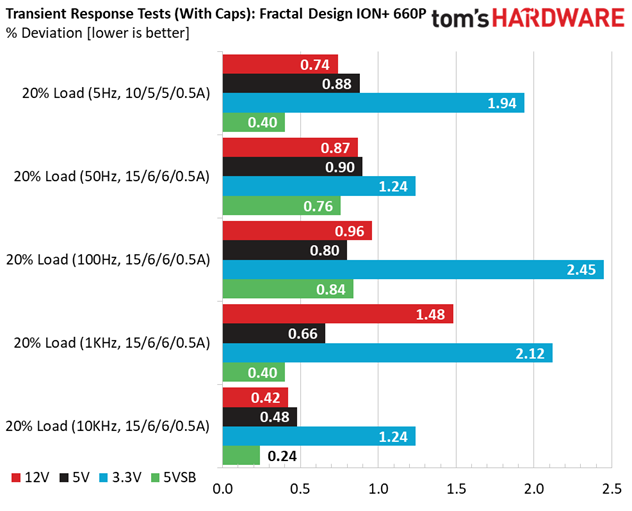
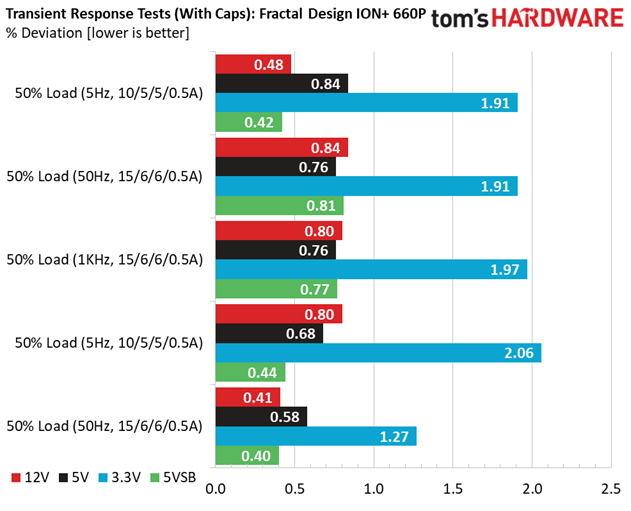

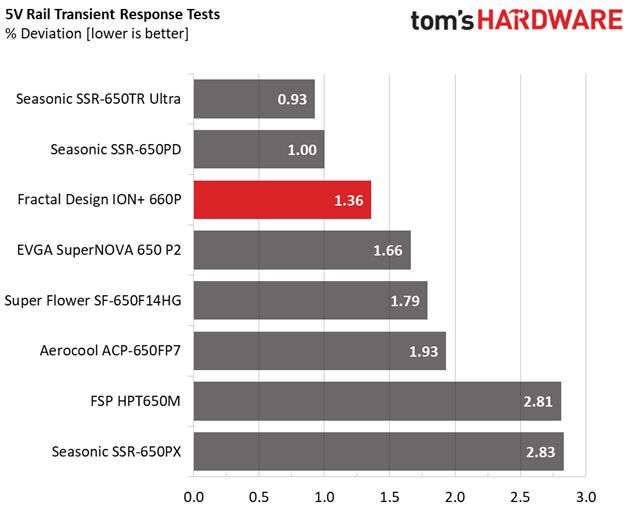


The transient response is satisfactory on all rails, especially the minor ones.
Turn-On Transient Tests
In the next set of tests, we measure the PSU's response in simpler transient load scenarios—during its power-on phase. Ideally, we don't want to see any voltage overshoots or spikes since those put a lot of stress on the DC-DC converters of installed components.



The results of these tests are very good.
Ripple Measurements
Ripple represents the AC fluctuations (periodic) and noise (random) found in the PSU's DC rails. This phenomenon significantly decreases the capacitors' lifespan because it causes them to run hotter. A 10 degrees Celsius increase can cut into a cap's useful life by 50%. Ripple also plays an important role in overall system stability, especially when overclocking is involved.
Get Tom's Hardware's best news and in-depth reviews, straight to your inbox.
The ripple limits, according to the ATX specification, are 120mV (+12V) and 50mV (5V, 3.3V, and 5VSB).
| Test | 12V | 5V | 3.3V | 5VSB | Pass/Fail |
|---|---|---|---|---|---|
| 10% Load | 12.7 mV | 3.9 mV | 10.9 mV | 6.8 mV | Pass |
| 20% Load | 8.0 mV | 4.1 mV | 10.7 mV | 6.9 mV | Pass |
| 30% Load | 7.9 mV | 6.0 mV | 14.7 mV | 10.0 mV | Pass |
| 40% Load | 8.3 mV | 5.3 mV | 11.8 mV | 7.7 mV | Pass |
| 50% Load | 8.5 mV | 5.7 mV | 11.7 mV | 7.7 mV | Pass |
| 60% Load | 8.8 mV | 6.7 mV | 13.1 mV | 8.7 mV | Pass |
| 70% Load | 9.4 mV | 6.2 mV | 13.2 mV | 8.7 mV | Pass |
| 80% Load | 10.2 mV | 7.1 mV | 15.2 mV | 9.4 mV | Pass |
| 90% Load | 10.8 mV | 7.4 mV | 14.8 mV | 10.2 mV | Pass |
| 100% Load | 16.3 mV | 8.7 mV | 15.5 mV | 11.0 mV | Pass |
| 110% Load | 17.8 mV | 8.9 mV | 15.3 mV | 10.8 mV | Pass |
| Crossload 1 | 11.0 mV | 5.2 mV | 16.0 mV | 7.4 mV | Pass |
| Crossload 2 | 16.2 mV | 7.5 mV | 12.4 mV | 10.0 mV | Pass |

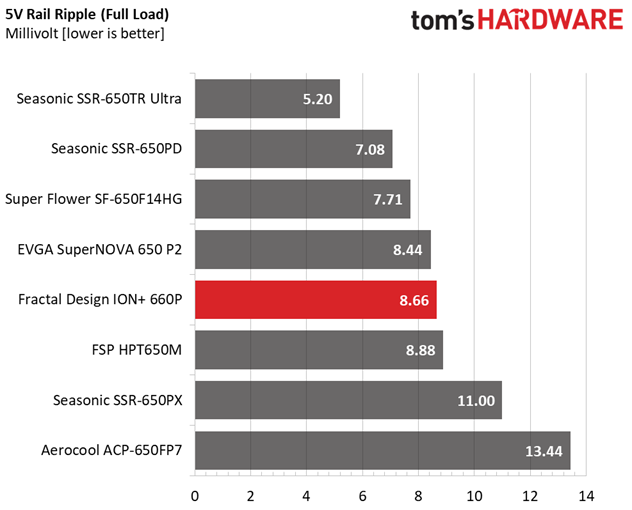

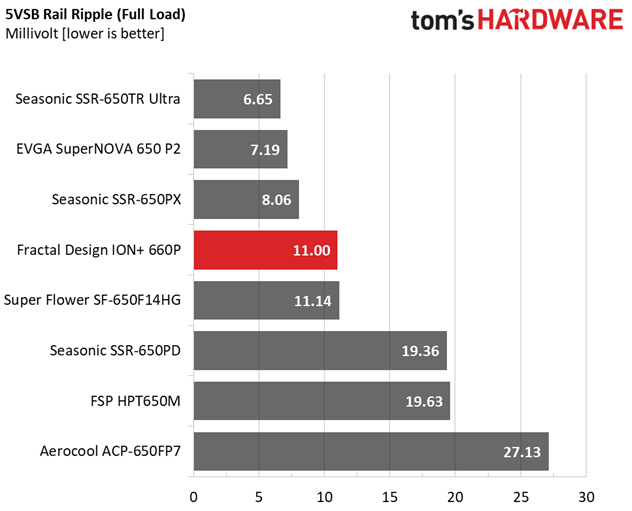
Ripple suppression is very good on all rails.
Ripple At Full Load




Ripple At 110% Load

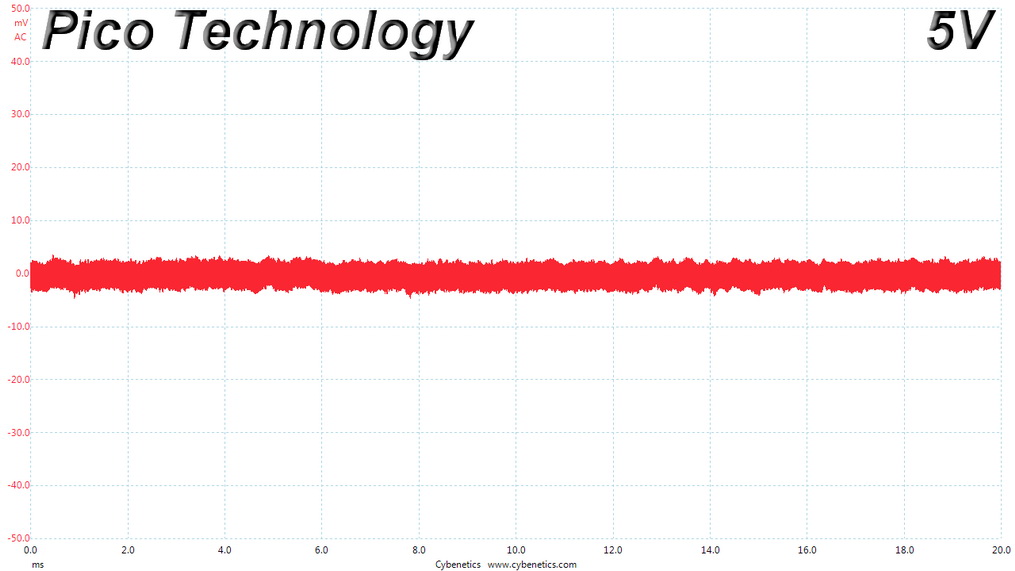
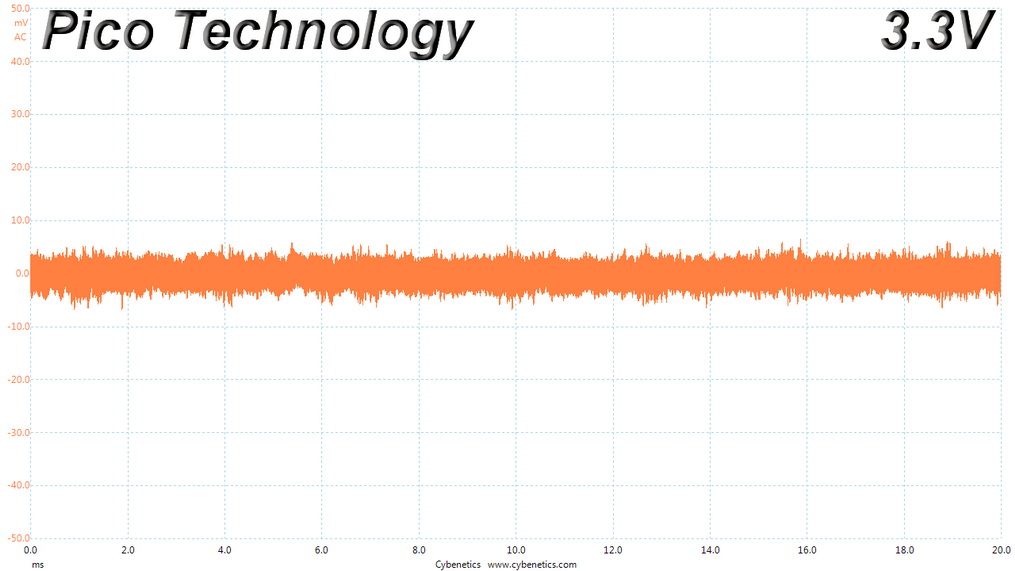

Ripple At Cross-Load 1



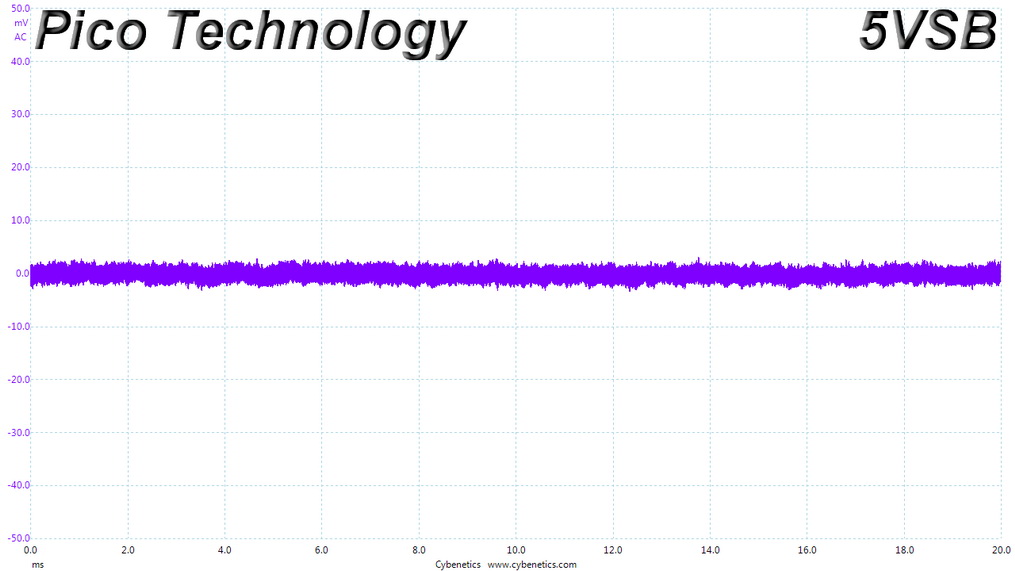
Ripple At Cross-Load 2


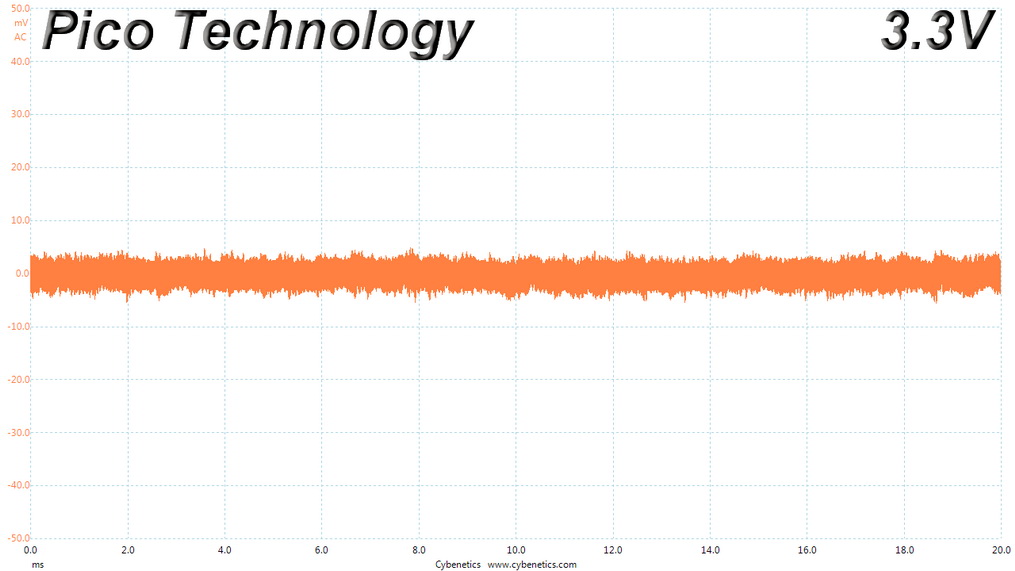
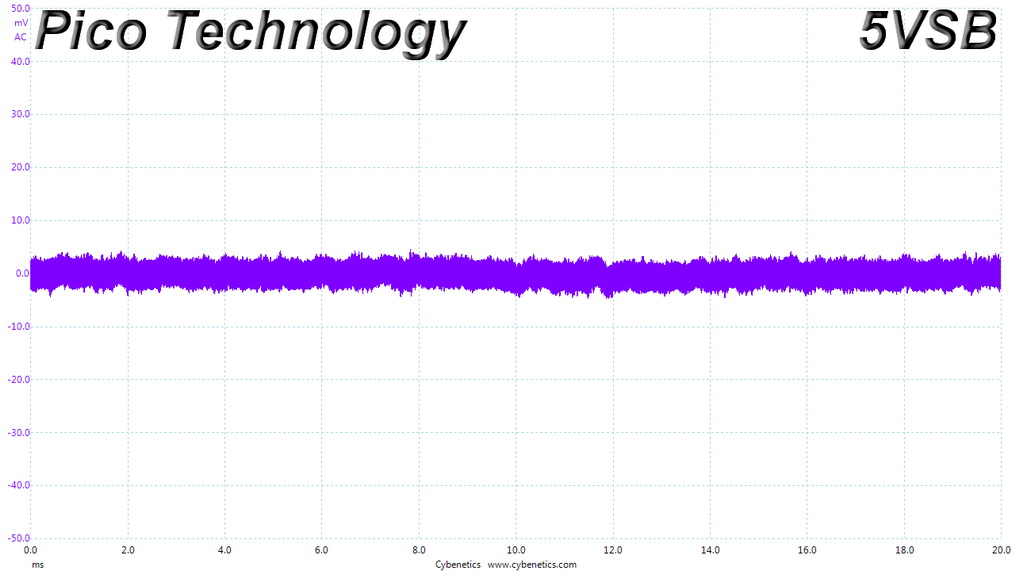
EMC Pre-Compliance Testing – Average and Peak EMI Detector Results
Electromagnetic Compatibility (EMC) is the ability of a device to operate properly in its environment without disrupting the proper operation of other close-by devices.
Electromagnetic Interference (EMI) stands for the electromagnetic energy a device emits, and it can cause problems in other close-by devices if too high. For example, it can be the cause of increased static noise in your headphones or/and speakers.
The conducted EMI emissions are in control.
MORE: Best Power Supplies
MORE: How We Test Power Supplies
MORE: All Power Supply Content
Current page: Transient Response Tests, Ripple Measurements and EMC Pre-Compliance Testing
Prev Page Protection Features, DC Power Sequencing, Cross-Load Tests and Infrared Images Next Page Performance, Noise and Efficiency
Aris Mpitziopoulos is a contributing editor at Tom's Hardware, covering PSUs.
-
redgarl Sooo... anandtech is having the exact opposite conclusion and even calling it the best Stirfa PSU series... are you even knowing what you are doing?Reply
https://www.anandtech.com/show/14693/the-fractal-design-ion-760p-80plus-platinum-psu-review/5
Electrically, the Ion+ 760P positively surprised us. As soon as we noticed that it is a design originating from Sirfa (High Power), we believed that most of the electrical figures would end up being mediocre, as Sirfa usually designs products that are competitive in terms of value, not performance. The Ion+ 760P is an entirely different story, delivering outstanding power quality across the entire load range and under any operating conditions, easily competing toe-to-toe with any other top-tier unit that we've reviewed so far. Furthermore, not only it is very efficient under normal circumstances, but it's able to maintain its exceptional energy conversion efficiency figures even when the ambient temperature gets very high. -
Aris_Mp Yes, I know very well what I am doing and if you bother to read the review and the provided data, you will also get an idea.Reply -
Carabyte This PSU has very low EMI compared to other's I'm seeing on your site. Do you have a page with the EMI chart for every PSU? I'd like to know what's the lowest EMI PSU you have found at 650-750Watt range. Meaning overall the least peaks, smooth and lowest peak. This one looks quite good, is it one of the best?Reply
Thanks!
Aris_Mp said:Yes, I know very well what I am doing and if you bother to read the review and the provided data, you will also get an idea.
